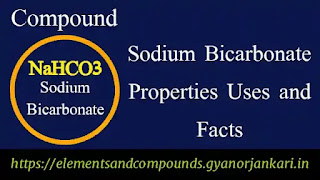Properties Uses and Facts about Hydrogen Peroxide
What is Sodium Bicarbonate
Sodium bicarbonate is also known as baking soda and bicarbonate of soda.
Sodium bicarbonate is a chemical compound having the chemical formula
(NaHCO3). Its one molecule contains one atom of sodium, one atom of
hydrogen, one atom of carbon and three atoms of oxygen. It is a salt that
dissolves in water and breaks down into sodium and bicarbonate. Sodium
bicarbonate is a white, crystalline, alkali, which is often found in the
form of a fine powder.
 |
| Sodium Bicarbonate Properties Uses and Facts |
Properties of Sodium Bicarbonate
- Sodium bicarbonate is a white, odorless, crystalline solid.
- Its density is 2.2 grams per cubic centimeter.
- Its taste is bitter and salty.
- Its melting point is 3000 degree Celsius.
- It is soluble in water, about 96 grams of it is soluble in one liter of water.
- On heating it decomposes into carbon dioxide gas and sodium carbonate.
- Its nature is alkaline, and its PH is 8.5.
- It reacts with acids to produce carbon dioxide gas.
Uses of Sodium Bicarbonate
- Sodium bicarbonate is used in cooking and mainly as a leavening agent in baking. When it reacts with the acid present in the food, carbon dioxide gas is released, making foods like cakes and bread spongy and leavened.
- Sodium bicarbonate is a mild disinfectant, and it can also be an effective fungicide against some organisms.
- Baking soda will absorb pungent odors, so it is used by booksellers to make books less smelly.
- Sodium bicarbonate is used to relieve heartburn, sour stomach, or acid indigestion by neutralizing excess acid in the stomach.
- It is said to belong to a group of medicines called antacids. It can also be used to treat the symptoms of stomach or duodenal ulcers.
- Heating sodium bicarbonate releases carbon dioxide gas, so it can be used to extinguish small fires. For this, it is thrown directly into the fire, due to which it heats up in the fire and releases carbon dioxide gas and the fire is extinguished. But it should not be used to extinguish the fire in the pan of hot oil, when it is put in hot oil, suddenly carbon dioxide gas is formed, which can cause explosion and the splashes of hot oil can cause damage by spreading all around.
- In agriculture, sodium bicarbonate is used to inhibit the growth of fungus on plant leaves by dissolving it in water and spraying it on the leaves. But using it in excess can spoil the color of the fruit.
- Sodium bicarbonate is used as an ingredient in some mouthwashes. It has anti and abrasive properties. It acts as a cleanser on the teeth and gums, neutralizing the production of acid in the mouth, and also acts as an antiseptic to help prevent infection.
- Sodium bicarbonate is used to remove paint and rust in a process called sodablasting. As a blasting medium, sodium bicarbonate is used to remove rust or paint from the surface of soft and less malleable materials such as aluminum, copper, and wood, which may be damaged by abrasive media such as silica sand.
- It is also used in making many types of beauty products.
Facts about Sodium Bicarbonate
- Concentrated sodium bicarbonate solution can cause severe eye and skin irritation. Under normal circumstances, it is not toxic and dangerous. But its overdose can cause shortness of breath, muscle spasms, mood changes, tremors and seizures. Caution should be exercised while administering sodium bicarbonate to patients suffering from renal failure, high blood pressure, cardiac arrest and kidney stones.
- Commercially, sodium bicarbonate is produced by reacting ammonia, carbon dioxide, and a brine solution (a solution of salt and water). NaCl+H2O+CO2+NH3→NH4Cl+NaHCO3.
Detailed Information on Some other Compounds
- Zinc Nitrate Properties Uses and other Details
- Aluminium Nitride Properties Uses and other Details
- Hydroiodic acid Properties Uses and other Details
- Dinitrogen Pentoxide Properties Uses and other Details
- Iodic Acid HIO3 Properties Uses and other Details
- Phosphine (PH3) Properties Uses and other information
- Ethanol Properties Uses and Other Details
- Potassium Cyanide | Properties | Uses | Other Details
- Sodium Hydroxide | Properties | Uses | Facts
- Methane Gas | Properties | Uses | Facts
- Ammonia | Properties | Uses | and Facts
- Sulfuric Acid H2SO4 | Properties | Uses | and Facts
- Nitric Acid HNO3 | Properties | Uses | and Facts
- Hydrochloric Acid HCL | Properties | Uses | and Facts
- Potassium Nitrate KNO3 | Properties | Uses | and Facts
- Hydrogen Peroxide H2O2 | Properties | Uses | and Facts






No comments:
Post a Comment